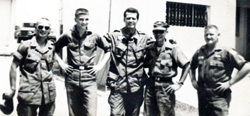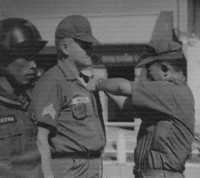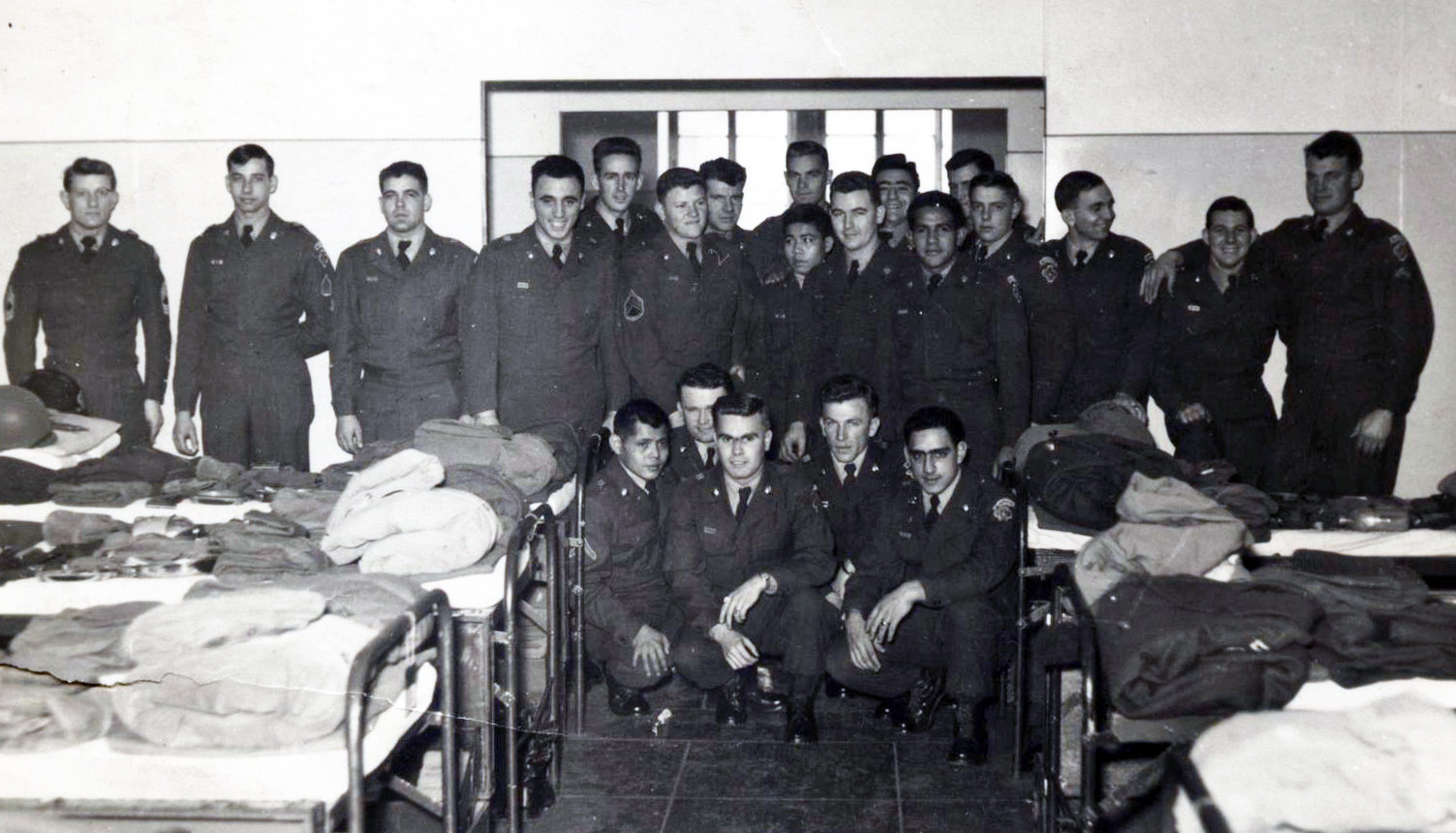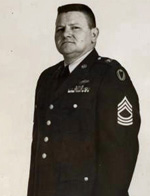
|

|
 | |
|
An up close and personal interview with U.S. Army Veteran and Togetherweserved.com Member:
MSG Haston Presnell U.S. Army (Ret) (1951-1972)
PLEASE DESCRIBE WHO OR WHAT INFLUENCED YOUR DECISION TO JOIN THE ARMY?
I had two uncles I admired who served in WWII and a neighbor that told me lots of stories about his service. My father had been in the Navy. So this sounded like an exciting life. I had dropped out of school and was working for a contractor building a post office in Highpoint NC but when the job finished I couldn't readily find another.
A friend and I decided to check out joining the service. We found an Army Recruiting Office in Raleigh and after hitching home to Burnsville to get a permission slip notarized we returned. I joined but my friend backed out at the last minute and I was on my way by rail to Fort Jackson SC by during the evening of March 23, 1951 and a great life to follow.
WHETHER YOU WERE IN THE SERVICE FOR SEVERAL YEARS OR AS A CAREER, PLEASE DESCRIBE THE DIRECTION OR PATH YOU TOOK.
It started in March 1951 with 14 weeks Infantry basic at Fort Jackson SC. Our 1st Sgt. Cloyce Silver keep telling us that most likely Korea was where we were headed so I trained hard.
Next assignment was to an Infantry Platoon with Co L 351st Infantry, Trieste, Italy. After making  Corporal I attended the TRUST NCO Academy at Sistani and in 1953 I was promoted to Sgt. and transferred to the Weapons Platoon as a Squad Leader. In February 1954 I was given the job as Weapons Platoon Sergeant. Corporal I attended the TRUST NCO Academy at Sistani and in 1953 I was promoted to Sgt. and transferred to the Weapons Platoon as a Squad Leader. In February 1954 I was given the job as Weapons Platoon Sergeant.
I was assigned to Instructor Co at Fort Stewart GA as a small arms instructor.
I returned overseas to Co I, 60 Infantry 9th Division in Heilbronn Germany which later moved to Fort Carson CO and was renamed the 2nd Recon Squadron 9th Cavalry. I spent most of my time as a train fire instructor for advance trainees.
Again the unit moved oversees and my MOS was changed to 113 and I was assigned to Co B as the Headquarters Platoon Sergeant and when in the field as the Squadron Liaison Sergeant. We replaced units of the 2nd Armored Cavalry on a rotating basis at various Border Camps located along the East German Border. My job title was Border Operations Sergeant.
Back to US and assigned to 3d Battalion 32d Armored at Fort Stewart, Ga. Again training recruits initially, then assigned to a tank engine rebuild shop as the Crew Leader where we converted tank engines from gas to diesel. Great job but again the battalion was moved as a unit to Augsburg Germany and I was given the job as the S-2 Sergeant. I was promoted and assigned as the S-2 Sergeant at 2nd Battalion 34th Infantry.
Next assignment was to the 4th Logistical Command at Fort Lee Virginia where I was assigned to monitor the combat readiness of 43 Line of Communication Units located throughout the US and compiled their readiness for reporting same at weekly briefings.
 In 1966 I went to Vietnam where I assigned as Team Sergeant for five-man Sub Sector MACV Advisory Team in Giong Trom (Giồng Trôm) District, Kien Hoa Province in the Delta Region. I worked with two Regional Force companies and the District Regional Forces and staff. The photo is from my first tour near our team house in Giong Trom. From left to right are Cpt. Mullett, unknown radio operator, actor James Garner (Visitor) Major Bowen and me. In 1966 I went to Vietnam where I assigned as Team Sergeant for five-man Sub Sector MACV Advisory Team in Giong Trom (Giồng Trôm) District, Kien Hoa Province in the Delta Region. I worked with two Regional Force companies and the District Regional Forces and staff. The photo is from my first tour near our team house in Giong Trom. From left to right are Cpt. Mullett, unknown radio operator, actor James Garner (Visitor) Major Bowen and me.
When my tour ended I rotated back to Germany and was assigned to the 2nd Brigade, 24th Infantry Division in Augsburg Germany. At this point it is a little difficult to follow the assignments as the brigade moved three times to different Kaserne and was reformed as the 24th Infantry Division (Forward) Headquarters that would remain in Europe as a lead element while the remainder of the division moved to Fort Riley Kansas. I was moved from the S-2 Intelligence NCO to the Brigade S-3 Operations Sgt. and held that job until orders arrive returning me to Vietnam.
On my second tour in Vietnam I was assigned to the Operations Center 1st Battalion, 5th Cavalry, 1st Cav Division (Airmobile) and worked as the S2/S3 on rotating shifts. During the year I was fortunate to be loaned to the 11th Armored Cavalry Regiment and worked as their Operations Sgt. for a few weeks and made an "Honoree Member" of that unit.
 The 1/5th was also assigned to reinforce the Bu-Dop Special Forces Camp for more than a month and I was able to work along with their Operations Staff. I found a small spider monkey that went everywhere with me usually holding onto my ear while sitting on my shoulder. He was a great pet but I lost him one night during a terrible rain storm while trying to load helicopters with ammo for a unit fighting on Hill 153 not too far from Bu-Dop. During that assignment, my unit was one of the first into Cambodia. In addition to the enemy contact and operations we were also burdened with the thousands of tons of ammunition, weapons and food items our troops were finding and capturing. The 1/5th was also assigned to reinforce the Bu-Dop Special Forces Camp for more than a month and I was able to work along with their Operations Staff. I found a small spider monkey that went everywhere with me usually holding onto my ear while sitting on my shoulder. He was a great pet but I lost him one night during a terrible rain storm while trying to load helicopters with ammo for a unit fighting on Hill 153 not too far from Bu-Dop. During that assignment, my unit was one of the first into Cambodia. In addition to the enemy contact and operations we were also burdened with the thousands of tons of ammunition, weapons and food items our troops were finding and capturing.
I returned to Germany in 1970 and was assigned to the 2nd Brigade, 3d Armored Division and given the job as S-3 Operations Sgt. 3d Battalion, 36th Infantry. In this job I planned a unit move to Norway for training and worked with several division units conducting Army Training Test in Grafenwoher Training Center Germany.
I retired from the US Army in 1974.
DID YOU PARTICIPATE IN COMBAT OPERATIONS? IF SO, COULD YOU DESCRIBE THOSE WHICH WERE SIGNIFICANT TO YOU?
During my first tour in Vietnam I was assigned as Senior Enlisted Adviser of a five person team from May 1966 to May 1967. We received mortar rounds on or near our team house about every week throughout the year. I went out on operation with the Poplar  Force (PF) and two Regional Force (RF) companies and over thirty five times we were involved in fire fights with Vietcong. Force (PF) and two Regional Force (RF) companies and over thirty five times we were involved in fire fights with Vietcong.
Probably the most significant battle was on Nov 19, 1966 when I and Major Bowen accompanied two RF Companies on a heliborne operation to secure an area along the Giong Trom District and Ba Tri District borders to set up as a blocking force for an operation taking place in the Ba Tri District. As soon as we landed the LZ was hot and we had to fight our way out of it. As we moved to the objective we were hit by more enemy fire. We called in gunship support that caused the enemy to flee the battlefield and were able to take the objective which was a large enemy weapons cache site and over five tons of rice.
During the fighting I had been separated from my team leader, Major Bowen, but I had the radio with me and continued to coordinate artillery and gunship support until the objective was taken. I was recommended for the Bronze Star for Valor. However, this was never approved but I did receive the Vietnamese Cross of Gallantry for this action.
My Second tour in duty in Vietnam was from September 20, 1969 to September 24, 1970. This time I was assigned as the Intelligence NCO/Operations NCO 1st Battalion, 5th Cavalry, 1st Cavalry Division (Airmobile). We operated in an area about 100 miles from Saigon toward the area called the Fish Hook on the Cambodian border. My unit occupied nine different Fire Support Bases and I was loaned to two other units for short periods to help out in the operation centers. I was made an Honorary member of The Black Horse Regiment (11 ACR) while with them.
In early November 1969, the isolated Special Forces Camp at Bu Dop about four kilometers south of the Cambodian border came under a heavy attack by NVA and VC. A few days into the siege things looked bad for the Americans and the Vietnam defender. My unit, the 1/5 was called in to help repel the enemy with our massive fire power and air support. When we arrived the camp was under attack and the Ammo and Fuel storage areas were burning and ammunition cooking off. The fastest I ran in my life was from the chopper pad to the main bunker. My unit, the 1/5 was called in to help repel the enemy with our massive fire power and air support. When we arrived the camp was under attack and the Ammo and Fuel storage areas were burning and ammunition cooking off. The fastest I ran in my life was from the chopper pad to the main bunker.
One night FSB Jerri was firing a mission with 155mm artillery. The rounds were to land one grid square to the east of our location at Bu Dop. Tragically three rounds smashed into our compound wounding two soldiers. One lost part of his leg. Major Russell, the S-3 immediately called a check fire. Good thing! I was in one of the sleeping bunkers and one round badly damaged it and another one would have taken it out.
The siege at Bu Dop was not broken until November 11, 1969--one week after it began.
During the Cambodia Operation in May-June 1970 I was aboard the Battalion Command and Control helicopter. We were the third to land in what would become Fire Base North One. The landing area could have been a disaster for us as the enemy forces had a well set up defense with several heavy machine gun emplacements but the people manning them abandoned them as we landed.
After capturing thousands of tons of ammunition, weapons and supplies my Battalion moved north near Orang Cambodia and built FSB David. Our S-2/S-3 Operations were in the battalion tactical operations bunker so I never saw the field combat experienced by our rifle companies experience nearly every day. Our threat were the probing attacks, rocket and mortar fire that happened often. probing attacks, rocket and mortar fire that happened often.
One vicious attack against FSB David came on June 15, 1970. Under cover of darkness, fog and drizzle heavily armed North Vietnamese regulars attacked from several sides hopping to breach our defensive. The Stars and Stripes headline on June 16, 1970 read "Reds Creep through Fog To-Death."
Next morning we had 28 bodies along the dirt berm but only two had made it onto the firebase. We had several wounded but lost no one. As the S-2 Sgt. I was given the job of searching and burying them. I didn't find much but with help of a back hoe I buried 27 of them in a grave just outside the NE edge of the berm at David. I have often wondered if the NVA ever recovered the bodies they lost that night.
OF ALL YOUR DUTY STATIONS OR ASSIGNMENTS, WHICH ONE DO YOU HAVE FONDEST MEMORIES OF AND WHY? WHICH ONE WAS YOUR LEAST FAVORITE?
This is a difficult question. I cherish every day of my service and love the units I served with. I still remain in touch with many individuals from almost every unit. But to pick one unit it will have to be L Co, 3d Battalion 351 Infantry (Blue Devils). The training and help I received during the time I was there was the most instrumental in shaping my life and probably keeping me alive.
One story from that period is my favorite. It began in 1952, in Trieste, Italy (at that time the Free Territory of Trieste) and involved an American soldier and a young woman from Monfalcone. One evening around 6 p.m. in the fall of 1952 the soldier was walking by a trolley station in  Trieste Italy when he spotted a beautiful lady waiting to board a trolley. He tried to talk with her but she ignored him. Unwilling to give up he continued to come back as often as he could around that time of day to see if she would show up. She did and he continued trying to talk with her in the few Italian words he understood. Trieste Italy when he spotted a beautiful lady waiting to board a trolley. He tried to talk with her but she ignored him. Unwilling to give up he continued to come back as often as he could around that time of day to see if she would show up. She did and he continued trying to talk with her in the few Italian words he understood.
One day she surprised him by speaking to him and more surprisingly using excellent English. Her name was Elena. She told him that she worked for a Colonel Flick and his wife in Villa Giulia and at night stayed with her brother-in-law---an English Sergeant Major--and her sister in Trieste and would go home to Monfalcone on the weekends.
That Italian women and the American soldier were married on June 26, 1954. Elena and I have been together for 59 years.
I also have fond memories of Grafenwoher Germany. I was there training when my son was born in Stuttgart in December 1954 and again when my daughter was born in Augsburg in January 1960. My last time at Grafenwoher was 1971 acting as range coordinator for units of the 3d Armored Division training there. Range 42 was my favorite for that is where over time I had fired the M41, M47 and M60 Tanks.
Least favorite memory occurred on September 2, 1960. I was the liaison sergeant for 2nd Squadron 9th Cavalry living in tents at Camp Kasserine. Very early in the morning the 1st Sgt. said he wanted someone to go into town and get beer and ice so we could have a celebration for our CO who was leaving that evening. When my jeep driver and I returned we could only get close. They were ambulances and MP vehicles all over the place. An accident had occurred and the unit in the tents in the next row over from ours had been hit by an artillery shell. If I recall correctly they were part of the 12th Cavalry assigned to the 3rd Armored Division and 27 people had been killed and many more wounded. This was one of the worst peace time accidents that had happened at the time. No one in my unit 2/9 Cav was killed even though tents were shredded and blown down.
FROM YOUR ENTIRE SERVICE CAREER WHAT PARTICULAR MEMORY STANDS OUT?
There are two memories.
My wife and family stayed in Germany while I was on my second tour in Vietnam. She worked for the Civil Service in Augsburg. When my Vietnam tour ended I was flown directly to the United States. The train trip from the  west coast to the east coast to continue my trip back to my family and new assignment in Germany was long and disappointing. A new Defense Department policy designed to avoid service members from being insulted by the anti-Vietnam War sentiment that was gripping most Americans I was forced to wear civilian clothes. Not that my high and wide haircut did not give me away. Oh well. west coast to the east coast to continue my trip back to my family and new assignment in Germany was long and disappointing. A new Defense Department policy designed to avoid service members from being insulted by the anti-Vietnam War sentiment that was gripping most Americans I was forced to wear civilian clothes. Not that my high and wide haircut did not give me away. Oh well.
When I finely arrived in Germany I learned my wife was in the hospital with a badly burned hand from a defective steam press that had fallen on it at work. I also found out my orders assigning me as liaison between the Army and Air Force were changed to the 3d Armored Division. Both disappointments turned out alright. The Army hospital in Augsburg did a great job repairing her hand and later the Hospital in Frankfurt took over and continued the therapy. I found out about a year later that the SMJ of the 2nd Brigade 3rd Armored Division had seen my name on the replacement list and had my orders changed. It turned out to be a very rewarding job.
What could have been a bad memory began when I requested retirement. I asked to ride home on the SS United States"the fastest liner ever built"on its last trip before it was retired. That was approved but when we arrived in Bremerhaven I had my mother-in-law with us and she was legally blind. The ship's doctor decided it was too much of a hazard for her to go by ship. My car and hold baggage made the trip, but we returned by train to Frankfurt and flew home. While we were disappointed we didn't sail on the last voyage of the SS United States things turned out better than expected. My wife and I had a wonderful relaxed trip from North Carolina to pick up our car and baggage in New York and then back to North Carolina.
OF ALL THE MEDALS, AWARDS, QUALIFICATION BADGES OR DEVICE YOU RECEIVED, PLEASE DESCRIBE THE ONE(S) MOST MEANINGFUL TO YOU AND WHY?
 The Combat Infantry Badge (CIB) is the most meaningful to me. I was awarded the CIB on my first Vietnam tour as a MACV Advisory duty on what they described as "exceptional criteria." The Combat Infantry Badge (CIB) is the most meaningful to me. I was awarded the CIB on my first Vietnam tour as a MACV Advisory duty on what they described as "exceptional criteria."
On my second tour after a short time with the 1st Cavalry (AM) I received another set of orders for the CIB. I know only one CIB can be worn for the same war but I enjoyed showing both sets of orders.
WHICH INDIVIDUAL(S) FROM YOUR TIME IN THE MILITARY STAND OUT AS HAVING THE MOST POSITIVE IMPACT ON YOU AND WHY?
I could fill a book of those who impacted me in a positive way but I will list four:
Master Sgt. Cloyce Silver. As the First Sgt. during of my basic training company he worked me hard and when I completed basic I felt like a soldier. Photo shows  Master Sgt. Silver on the left in front of our barracks at Tank Hill at Ft. Jackson. Master Sgt. Silver on the left in front of our barracks at Tank Hill at Ft. Jackson.
Master Sgt. Jerry Wilcox the 1st Platoon Sgt. Co L 351 Infantry (TRUST). He was a soldier's soldier and an example for all and a person I thought of when I had a decision to make.
Maj. Cecil Bowman, my Team Chief in Advisory Team 93 Giong Trom Sub-sector. His knowledge and ability to work with Vietnam village and district management was outstanding and was probably one reason our team never lost an adviser during the entire year we were together.
Lt. Col. Eugene Russell, Operations Officer 1st Bn 5th Cavalry. His planning and knowledge of Air mobile Operations was without doubt the best I observed while in Vietnam.
I am still in touch with all these except Master Sgt. Cloyce Silver who passed on a few years ago.
CAN YOU RECOUNT A PARTICULAR INCIDENT FROM YOUR SERVICE WHICH MAY OR MAY NOT HAVE BEEN FUNNY AT THE TIME, BUT STILL MAKES YOU LAUGH?
On my last day with the 1st Cavalry I had turned in my weapon and a helicopter picked me and the First Sgt. from Co C 1/5th up for our trip from Cambodia to Ben Hoa where we would be flown home. We were flying along at a fairly low level following the Song Be River on what was an exceptionally beautiful day. Suddenly the door gunners opened fire; the helicopter banked left and started to climb. I heard a couple of thuds that I thought were small arms fire hitting the chopper. It scared the hell out of both the First Sgt. and me.  Neither of us had a weapon and didn't know what was happening. Neither of us had a weapon and didn't know what was happening.
When things quieted down I got my breath back and we continued on to Ben Hoa. When we landed we met Lt. Col. Russell who was there for something else and he and the chopper crew were laughing so hard they couldn't talk.
They had planned the entire thing back at FSB David. They waited for an open area when the rounds would not hit anyone or animals and the thuds were made by the co-pilots boot heel. There were too many of them for the two of us to whip. So I just laughed along with them.
WHAT PROFESSION DID YOU FOLLOW AFTER YOUR MILITARY SERVICE AND WHAT ARE YOU DOING NOW? IF YOU ARE CURRENTLY SERVING, WHAT IS YOUR PRESENT OCCUPATIONAL SPECIALTY?
I went back to work and school after retiring from US Army for the Virginia Department of Transportation (VDOT). I was able to get my degree as a Civil Engineer and in my 34 years with VDOT the positions I held were Materials Technician, Concrete Engineer and Training Manager. After I retired in March 2007, I volunteer at the VA Hospital in Richmond VA working with the wounded warrior program and playing golf when I can.
WHAT MILITARY ASSOCIATIONS ARE YOU A MEMBER OF, IF ANY? WHAT SPECIFIC BENEFITS DO YOU DERIVE FROM YOUR MEMBERSHIPS?
 1st Cavalry Division Association and occasionally work with their Eastern Region Chapter's Wounded Warrior program at Walter Reed and VA Hospital Richmond. 1st Cavalry Division Association and occasionally work with their Eastern Region Chapter's Wounded Warrior program at Walter Reed and VA Hospital Richmond.
I am also a member of the 88th Infantry Division Association. Both provide fellowship with former military types like me.
IN WHAT WAYS HAS SERVING IN THE MILITARY INFLUENCED THE WAY YOU HAVE APPROACHED YOUR LIFE AND YOUR CAREER?
The leadership positions I held in the Army have influenced me my entire life. In my civilian career the many leadership traits I experienced and observed in the Army prepared me to meet the challenges as a manager at VDOT. If nothing else the Army taught me to pay attention to details and to listen to others.
The culmination of my Army experience made me a better person, husband and father.
BASED ON YOUR OWN EXPERIENCES, WHAT ADVICE WOULD YOU GIVE TO THOSE WHO HAVE RECENTLY JOINED THE ARMY?
 Give it your best; learn from every event and situation. Take care of your people/team and follow orders but ask questions and make suggestions. Listen to others. Give it your best; learn from every event and situation. Take care of your people/team and follow orders but ask questions and make suggestions. Listen to others.
Some of the best advice I received and most likely kept me alive was from a Vietnamese Sergeant that I was assigned to advice. He was a Viet Minh fighting the French and a Viet Cong fighting the South Vietnamese government before going over to the South Vietnamese military. I decided quickly that with experience like that that I needed to listen and observe more than advice.
IN WHAT WAYS HAS TOGETHERWESERVED.COM HELPED YOU REMEMBER YOUR MILITARY SERVICE AND THE FRIENDS YOU SERVED WITH.
This is a great place to find old friends and make new friends I love all the features and I review the postings and great stories every day in the Forums.
Looking through old photos to add to my profile, I ran across one from First Platoon Company L 351 Infantry TRUST Forces taken in 1952 in Trieste Italy. I started trying to find someone from the group and was able to find two that I am in touch with and another person's widow who was happy to hear from me. I was able to provide her several pictures of her husband that she didn't have. Neither uses a computer so I was not able to get them to join Army Together We Served right away but encouraged them to have a family member post their profile for them. This is a great place to find old friends and make new friends I love all the features and I review the postings and great stories every day in the Forums. away but encouraged them to have a family member post their profile for them. This is a great place to find old friends and make new friends I love all the features and I review the postings and great stories every day in the Forums.
The first person on the left is one of the people I listed as being a great influence on me during my career; MSG Jerry Wilcox and he is still well and healthy and we talk by telephone and regular mail and he was able to help me remember the names on this picture. I am number 6 from the left just in front of Harry Wagner who was my best man at my wedding in 1954.
|

MSG Haston Presnell
|
|
Share this Voices Edition on:



 |
|
TWS VOICES
TWS Voices are the personal stories of men and women who served in the US Military and convey how serving their Country has made a positive impact on their lives. If you would like to participate in a future edition of Voices, or know someone who might be interested, please contact TWS Voices HERE.
This edition of Army Voices was supported by:
Army.Togetherweserved.com
For current and former serving Members of the US Army, US Army Reserve and US Army National Guard, TogetherWeServed.com is a unique, feature rich resource helping Soldiers re-connect with lost Brothers, share memories and tell their Army story.
To join Army.Togetherweserved.com, please click HERE.
| |